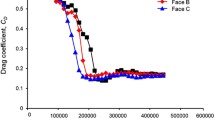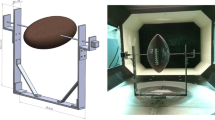Abstract
When the boundary layer of a sports ball undergoes the transition from laminar to turbulent flow, a drag crisis occurs whereby the drag coefficient (C d) rapidly decreases. However, the aerodynamic properties and boundary-layer dynamics of a soccer ball are not yet well understood. In this study we showed that the critical Reynolds number (Re crit) of soccer balls ranged from 2.2 × 105 to 3.0 × 105. Wind-tunnel testing, along with visualisation of the dynamics of the boundary layer and the trailing vortex of a ball in flight, demonstrated that both non-spinning and spinning (curved) balls had lowC d values in the super-critical region. In addition, theRe crit values of the soccer balls were lower than those of smooth spheres, ranging from ∼ 3.5 × 105 to 4.0 × 105, due to the effects of their panels. This indicated that the aerodynamic properties of a soccer ball were intermediate between those of a smooth ball and a golf ball. In a flow visualisation experiment, the separation point retreated and theC d decreased in a super-critical regime compared with those in a sub-critical regime, suggesting a phenomenon similar to that observed in other sports balls. With some non-spinning and spinning soccer balls, the wake varied over time. In general, the high-frequency component of an eddy dissipated, while the low-frequency component increased as the downstream vortex increased. The causes of the large-scale fluctuations in the vortex observed in the present study were unclear; however, it is possible that a ‘knuckle-ball effect’ of the non-rotating ball played a role in this phenomenon.
Similar content being viewed by others
References
Achenbach, E. (1972) Experiments on the flow past spheres at very high Reynolds numbers.Journal of Fluid Mechanics,54, 565–575.
Achenbach, E. (1974) The effects of surface roughness and tunnel blockage on the flow past spheres.Journal of Fluid Mechanics,56, 113–125.
Asai, T., Akatsuka, T. & Haake, S.J. (1998) The physics of football.Physics World,11, 25–27.
Asai, T., Carré, M.J., Akatsuka, T. & Haake, S.J. (2002) The curve kick of a football, I: impact with the ball.Sports Engineering,5(4), 183–192.
Asai, T., Seo, K., Kobayashi, O. & Sakashita, R. (2006) Flow visualization on a real flight non-spinning and spinning soccer ball, in E.F. Moritz & S.J. Haake (eds)The Engineering of Sport 6, Vol. 1, pp. 327–332. International Sports Engineering Association, Sheffield.
Barber, S., Haake, S.J. & Carré, M.J. (2006) Using CFD to understand the effects of seam geometry on soccer ball aerodynamics, inThe Engineering of Sport 6, Vol. 2, pp. 127–132. International Sports Engineering Association, Sheffield.
Bearman, P.W. & Harvey, J.K. (1976) Golf ball aerodynamics.Aeronautical Quarterly,27, 112–122.
Briggs, L.J. (1959) Effect of spin and speed on the lateral deflection (curve) of a baseball; and the Magnus effect for smooth spheres.American Journal of Physics,27, 589–596.
Carré, M.J. & Asai, T. (2004) Biomechanics and aerodynamics in soccer, in G.K. Hung & J.M. Pallis (eds)Biomedical Engineering Principles in Sports, pp. 333–364. Kluwer Academic Plenum Publishers, New York.
Carré, M.J., Asai, T., Akatsuka, T. & Haake, S.J. (2002) The curve kick of a football, II: flight through the air.Sports Engineering,5(4), 193–200.
Carré, M.J., Goodwill, S.R., Haake, S.J., Hanna, R.K. & Wilms, J. (2004) Understanding the aerodynamics of a spinning soccer ball, in M. Hubbard, R.D. Mehta & J.M. Pallis (eds)The Engineering of Sport 5, Vol. 1, pp. 70–76. International Sports Engineering Association, Sheffield.
Carré, M.J., Goodwill, S.R. & Haake, S.J. (2005) Understanding the effect of seams on the aerodynamics of an association football.Proceedings of the Institution of Mechanical Engineers, Part C: Journal of Mechanical Engineering Science,219, 657–666.
Chadwick, S.G. & Haake, S.J. (2000) The drag coefficient of tennis balls, in A. Subic & S.J. Haake (eds)The Engineering of Sport, pp. 169–176. Blackwell Science, Oxford.
Davies, J.M. (1949) The aerodynamics of golf balls.Journal of Applied Physics,20, 821–828.
Haake, S.J., Chadwick, S.G., Dignall, R.J., Goodwill, S.R. & Rose, P. (2000) Engineering tennisslowing the game down.Sports Engineering,3, 131–143.
Magnus, G. (1852) On the derivation of projectiles; and on a remarkable phenomenon of rotating bodies, in J. Tyndall & W. Francis (eds)Memoirs of the Royal Academy, Berlin, Germany. English translation inScientific Memoirs, p. 210. London (1853).
Mehta, R. (1985) Aerodynamics of sports balls.Annual Review of Fluid Mechanics,17, 151–189.
Mehta, R.D., Bentley, K., Proudlove, M. & Varty, P. (1983) Factors affecting cricket ball swing.Nature,303, 787–788.
Seo, K., Kobayashi, O. & Murakami, M. (2004) Regular and irregular motion of a rugby football during flight, in M. Hubbard, R.D. Mehta & J.M. Pallis (eds)The Engineering of Sport 5, Vol. 1, pp. 567–573. International Sports Engineering Association, Sheffield.
Smits, A.J. & Ogg, S. (2004) Aerodynamics of golf ball, in G.K. Hung & J.M. Pallis (eds)Biomedical Engineering Principles in Sports, pp. 333–364. Kluwer Academic Plenum Publishers, New York.
Stepanek, A. (1988) The aerodynamics of tennis balls —the topspin lob.American Journal of Physics,56, 138–142.
Taneda, S. (1978) Visual observations of the flow past a sphere at Reynolds numbers between 104 and 106.Journal of Fluid Mechanics,85, 187.
Thompson, J.J. (1910) The dynamics of a golf ball.Nature,85, 2151–2157.
Watts, R.G. & Ferrer, R. (1987) The lateral force on a spinning sphere: aerodynamics of a curveball.American Journal of Physics,55, 40–44.
Watts, R.G. & Sawyer, E. (1975) Aerodynamics of a knuckleball.American Journal of Physics,43, 960–963.
Wei, Q., Lin, R. & Liu, Z. (1988) Vortex-induced dynamics loads on a non-spinning volleyball.Fluid Dynamics Research,3, 231–237.
Author information
Authors and Affiliations
Corresponding author
Rights and permissions
About this article
Cite this article
Asai, T., Seo, K., Kobayashi, O. et al. Fundamental aerodynamics of the soccer ball. Sports Eng 10, 101–109 (2007). https://doi.org/10.1007/BF02844207
Issue Date:
DOI: https://doi.org/10.1007/BF02844207




